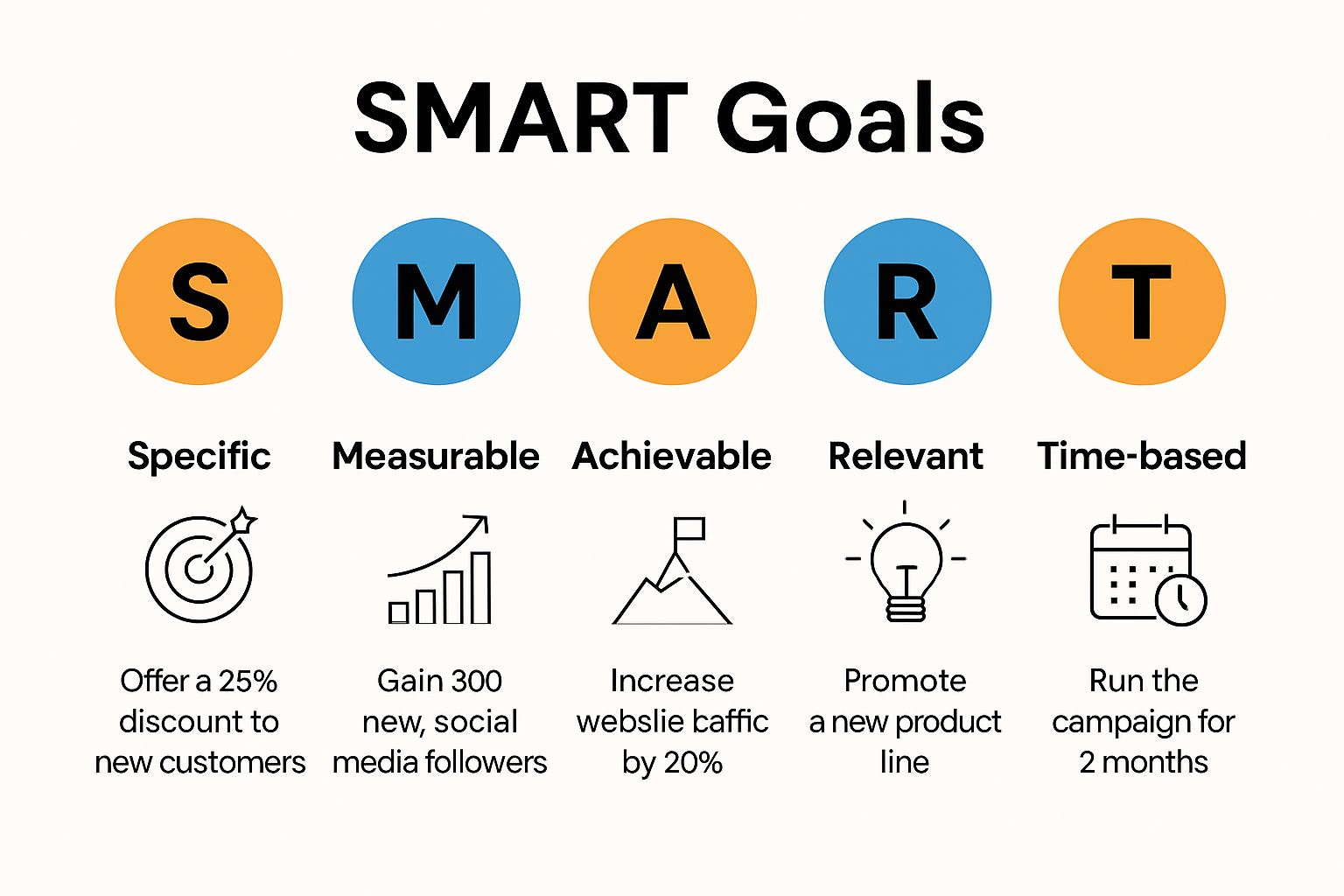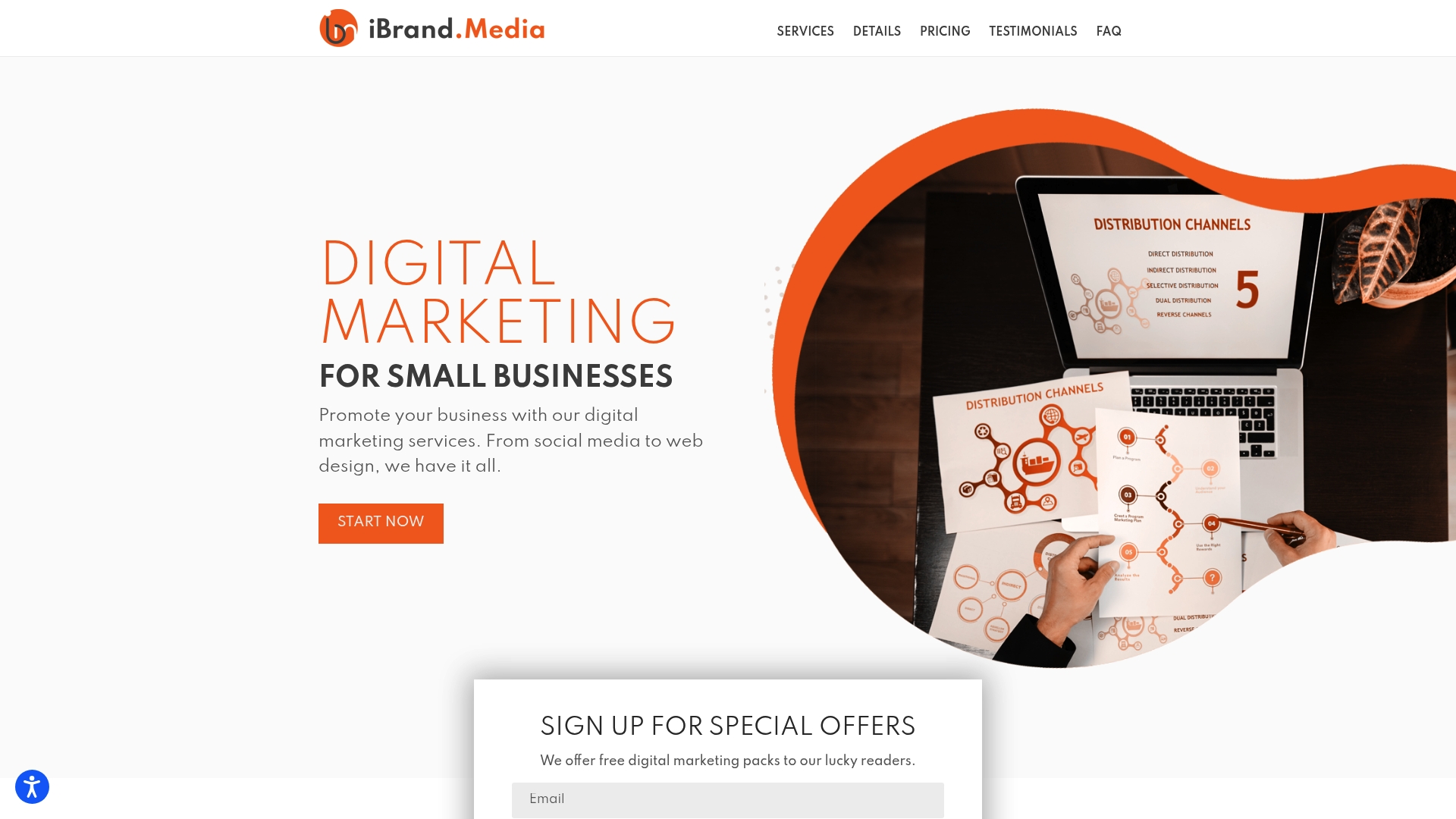Setting marketing goals might sound routine for a small business, but the stakes are higher than most realize. Here is something unexpected. Research shows that firms with well-defined marketing goals experience significantly higher growth rates than those without structured objectives. Now, forget the usual advice about setting vague targets for the year. The secret to real growth is making sure your goals are few, specific, and ruthlessly measured.
Table of Contents
- Why Setting Marketing Goals Matters
- The Strategic Foundation Of Marketing Goals
- Quantifying The Impact Of Strategic Marketing Planning
- Steps To Define Effective Marketing Goals
- Understanding The SMART Goal Framework
- Conducting A Comprehensive Business Assessment
- Prioritizing And Limiting Marketing Objectives
- SMART Goals For Local And Service Businesses
- Tailoring Goals To Local Business Realities
- Practical Examples Of SMART Marketing Goals
- Implementing And Tracking Local Business Marketing Goals
- Tracking Progress And Adjusting Your Goals
- Establishing Key Performance Indicators (KPIs)
- Conducting Regular Strategic Reviews
- Implementing Adaptive Strategy Frameworks
Quick Summary
| Takeaway | Explanation |
|---|---|
| The Importance of Marketing Goals | Clear marketing goals provide a strategic framework that guides small businesses toward sustainable growth and resource optimization, serving as a roadmap for success in a competitive marketplace. |
| SMART Goal Framework | Utilizing the SMART (Specific, Measurable, Achievable, Relevant, Time-based) methodology ensures that marketing objectives are well-defined and achievable, driving focused action and measurable results. |
| Comprehensive Business Assessment | Conducting a thorough internal and external analysis before setting goals allows businesses to identify market opportunities and align their marketing strategies with their unique operational capabilities. |
| Prioritization of Objectives | Limiting marketing objectives to three or four key areas prevents overwhelm and increases the likelihood of successful implementation, facilitating focused resource allocation. |
| Continuous Tracking and Adaptation | Regularly monitoring Key Performance Indicators (KPIs) and conducting strategic reviews enable businesses to assess progress and make informed adjustments to their marketing strategies. |
Why Setting Marketing Goals Matters
Marketing goals serve as the strategic compass guiding small businesses toward sustainable growth and competitive advantage. Without clear objectives, businesses risk wandering aimlessly in a complex digital marketplace, wasting resources and missing critical opportunities for expansion.
The Strategic Foundation of Marketing Goals
Setting precise marketing goals transforms abstract business aspirations into actionable strategies. Research from strategic management experts reveals that firms with well-defined marketing capabilities experience significantly higher growth rates compared to those operating without structured objectives.
Small businesses operate in an increasingly competitive environment where strategic precision determines survival and success. Marketing goals provide multiple critical advantages:
- Directional Clarity: Create a roadmap that aligns marketing efforts with overall business vision
- Resource Optimization: Ensure targeted allocation of limited marketing budgets
- Performance Measurement: Establish quantifiable benchmarks for tracking progress
Quantifying the Impact of Strategic Marketing Planning
Recent studies from business research institutions demonstrate that small businesses engaging in comprehensive strategic planning are more likely to experience growth across multiple dimensions, including employment, revenue, and investment potential.
The data underscores a fundamental truth: marketing goals are not mere administrative exercises but powerful instruments of business transformation. They convert vague intentions into structured plans, enabling businesses to:
- Identify precise target audiences
- Develop focused marketing strategies
- Allocate resources efficiently
- Track and adjust performance continuously
By establishing clear marketing goals, small businesses create a structured approach that maximizes their potential for success. These goals serve as a strategic framework, helping entrepreneurs navigate market complexities with confidence and purpose.
For small business owners looking to develop a more comprehensive approach to marketing strategy, learn more about crafting effective digital marketing objectives to transform your business trajectory in 2025 and beyond.
Steps to Define Effective Marketing Goals

Defining effective marketing goals requires a strategic approach that transforms business aspirations into actionable, measurable objectives. Small businesses must navigate this process with precision and clarity to maximize their marketing potential.
Understanding the SMART Goal Framework

Experts recommend utilizing the SMART goal methodology when establishing marketing objectives. This framework ensures goals are:
- Specific: Clearly defined and unambiguous
- Measurable: Quantifiable with concrete metrics
- Achievable: Realistic within current business capabilities
- Relevant: Aligned with overall business strategy
- Time-based: Set with definitive timeframes
For instance, instead of a vague goal like “increase online visibility,” a SMART goal would be “Increase website traffic by 25% within the next six months through targeted SEO and content marketing strategies.”
To help you quickly understand each component of the SMART Goal Framework, below is a summary table outlining the key elements and their importance:
| SMART Component | What It Means | Importance |
|---|---|---|
| Specific | Clear, unambiguous objective | Focuses effort and reduces confusion |
| Measurable | Quantifiable with metrics | Enables tracking and assessment |
| Achievable | Realistic given available resources | Motivates progress and avoids frustration |
| Relevant | Aligned with business goals and strategy | Ensures effort is purposeful |
| Time-based | Defined deadlines or timeframes | Creates urgency and accountability |
Conducting a Comprehensive Business Assessment
Research from business development experts highlights the importance of conducting a thorough internal and external assessment before setting marketing goals. This process involves:
- Analyzing current business performance
- Identifying market opportunities
- Evaluating competitive landscape
- Understanding target audience demographics
- Assessing available resources and constraints
By performing a comprehensive evaluation, businesses can develop marketing goals that are both ambitious and achievable. Learn more about developing a strategic digital marketing approach to refine your goal-setting process.
Prioritizing and Limiting Marketing Objectives
Business strategy research suggests limiting marketing objectives to three or four key focus areas. This approach prevents overwhelm and increases the likelihood of successful implementation. Prioritization involves:
- Ranking potential goals by potential impact
- Considering resource requirements
- Aligning objectives with core business strategy
- Creating a focused, manageable action plan
Small businesses should concentrate on goals that offer the most significant potential for growth and market positioning. By carefully selecting and defining marketing objectives, entrepreneurs can create a powerful roadmap for business success in 2025 and beyond.
SMART Goals for Local and Service Businesses
Local and service businesses require specialized marketing goals that address their unique operational challenges and market dynamics. Understanding how to craft precise, actionable objectives can transform these businesses from struggling enterprises to thriving community enterprises.
Tailoring Goals to Local Business Realities
Research from the University of Houston’s Small Business Development Center emphasizes that successful goal-setting for local businesses involves focusing on key areas such as business finances, strategic planning, networking opportunities, and targeted expense reduction.
For service-based businesses like home contractors, HVAC specialists, and medical professionals, marketing goals must be hyper-specific. Consider these nuanced approaches:
- Geographic Targeting: Create goals that focus on local market penetration
- Service-Specific Metrics: Develop objectives around service conversion rates
- Customer Acquisition Cost: Track and minimize marketing expenditure per new client
Below is a table summarizing typical focus areas for local and service businesses when setting marketing goals:
| Focus Area | Why It’s Important | Example Goal |
|---|---|---|
| Geographic Targeting | Builds strong local brand presence | “Increase bookings in ZIP Code 12345 by 20% this quarter” |
| Service Conversion Rates | Measures marketing effectiveness for specific services | “Boost HVAC maintenance package sign-ups by 15% in 6 months” |
| Customer Acquisition Cost | Controls spending and maximizes ROI | “Reduce acquisition cost per new client by $50 by Q3” |
| Networking & Partnerships | Grows referrals and local awareness | “Attend 2 local business events monthly” |
| Strategic Expense Reduction | Maintains profitability and efficiency | “Lower marketing overhead by 10% this year” |
Practical Examples of SMART Marketing Goals
According to Australian Government business resources, effective SMART goals provide clear focus and motivate businesses toward tangible outcomes. For instance:
- A plumbing business might set a goal to “Increase local service bookings by 30% within four months through targeted Google local ads and community networking”
- A medical spa could aim to “Generate 50 new client consultations through Instagram targeted advertising by end of quarter”
- A home contractor could establish a goal to “Reduce customer acquisition cost by 15% using refined digital marketing strategies”
Implementing and Tracking Local Business Marketing Goals
Successful implementation requires consistent monitoring and adaptive strategies. Learn more about developing targeted local marketing approaches to refine your business growth strategy.
Key tracking mechanisms include:
- Monthly performance reviews
- Detailed analytics assessment
- Regular strategy adjustments
- Competitive benchmarking
Local and service businesses must recognize that marketing goals are not static documents but dynamic roadmaps. By embracing flexibility and maintaining a laser focus on measurable outcomes, entrepreneurs can navigate complex market landscapes with confidence and strategic precision.
The most successful businesses understand that goal-setting is an ongoing process of learning, adapting, and continuously improving their marketing approach.
Tracking Progress and Adjusting Your Goals
Tracking marketing goals is not a passive process but an active, strategic approach that transforms initial objectives into actionable results. Small businesses must develop robust systems for monitoring progress, analyzing performance, and making intelligent adaptations to their marketing strategies.
Establishing Key Performance Indicators (KPIs)
Research from marketing metrics experts emphasizes the critical importance of identifying and tracking specific Key Performance Indicators. These measurable values demonstrate how effectively a business is achieving its core marketing objectives.
Essential KPIs for small businesses typically include:
- Conversion Rates: Percentage of potential customers taking desired actions
- Customer Acquisition Cost: Total expense of gaining a new customer
- Website Traffic: Volume and quality of online visitor engagement
- Social Media Engagement: Likes, shares, comments, and interaction metrics
- Revenue Growth: Direct financial impact of marketing efforts
Below is a table summarizing key marketing KPIs small businesses should track and what each measures:
| KPI | What It Measures | Why It Matters |
|---|---|---|
| Conversion Rate | % of visitors who take desired action | Shows effectiveness of marketing campaigns |
| Customer Acquisition Cost | Average cost to acquire a new customer | Monitors marketing efficiency and ROI |
| Website Traffic | Number and quality of site visitors | Assesses online reach and engagement |
| Social Media Engagement | Likes, shares, comments, etc. | Evaluates audience interaction and brand awareness |
| Revenue Growth | Increase in sales/earnings over time | Indicates direct impact of marketing on business success |
Conducting Regular Strategic Reviews
Experts recommend implementing systematic review processes that allow businesses to evaluate progress and make informed adjustments. This involves:
- Monthly performance assessments
- Quarterly comprehensive strategy reviews
- Detailed analysis of marketing channel effectiveness
- Comparing actual results against initial projections
Explore advanced techniques for refining your digital marketing strategy to enhance your tracking and adjustment capabilities.
Implementing Adaptive Strategy Frameworks
Research from strategic management studies highlights the value of conducting regular SWOT analyses to evaluate internal strengths and weaknesses alongside external opportunities and threats. This approach enables businesses to:
- Identify emerging market trends
- Recognize potential strategic pivots
- Anticipate competitive challenges
- Develop proactive response mechanisms
Successful small businesses understand that marketing goals are dynamic documents. They require continuous monitoring, honest assessment, and willingness to adapt. The most effective entrepreneurs view their marketing strategies as living frameworks that evolve with market conditions, technological changes, and business growth.
By maintaining a flexible yet structured approach to goal tracking, small businesses can transform potential obstacles into opportunities for innovation and sustained growth. The key is not perfection, but consistent, intelligent adaptation.
Frequently Asked Questions
What are SMART goals in marketing?
SMART goals in marketing are objectives that are Specific, Measurable, Achievable, Relevant, and Time-based. They help businesses create clear and structured marketing strategies that drive focused action and measurable results.
Why is it important for small businesses to set marketing goals?
Setting marketing goals is crucial for small businesses as it provides a strategic framework that guides their efforts toward sustainable growth, optimizes resource allocation, and establishes benchmarks for measuring performance.
How can I prioritize my marketing goals effectively?
To prioritize marketing goals effectively, limit them to three or four key objectives, rank them by potential impact, align them with your overall business strategy, and create a manageable action plan to focus your efforts.
What key performance indicators (KPIs) should I track for my marketing goals?
Small businesses should track KPIs such as conversion rates, customer acquisition cost, website traffic, social media engagement, and revenue growth to measure the effectiveness of their marketing strategies.
Ready to Turn Marketing Goals Into Real Small Business Growth?
You have spent valuable time learning how to set precise, measurable marketing objectives. Maybe you are excited yet unsure where to begin. Or perhaps you feel overwhelmed trying to move from goal-setting to actual marketing action, especially with limited resources. That is a common challenge for small business owners who want results but struggle to implement SMART, trackable strategies that truly boost online presence, bring in new customers, and grow sales.

If you want to see your marketing goals transform into real outcomes, now is the perfect moment to act. Our team at ibrand.media specializes in affordable, hands-on digital marketing tailored just for small businesses like yours. Explore our Uncategorized section for ideas or success stories, or reach out for a custom plan built around your 2025 targets. Take the next step. Get the guidance and performance tracking you need to finally achieve and measure the growth you have been planning.
Recommended
- Setting Digital Marketing Goals for Small Businesses in 2025 | Ibrandmedia
- Developing a Digital Marketing Plan: A 2025 Guide for Small Businesses | Ibrandmedia
- Digital Marketing Basics for Small Businesses in 2025 | Ibrandmedia
- Social Media Marketing for Businesses: Strategies That Work in 2025 | Ibrandmedia
- What Is Digital Marketing? A Simple Guide for Small Businesses (2025) | Ibrandmedia
- Why Digital Marketing Matters for Small Businesses in 2025 | Ibrandmedia
- Unlock the Full Potential of SEO with AI

Recent Comments